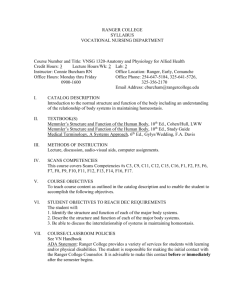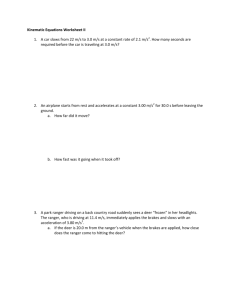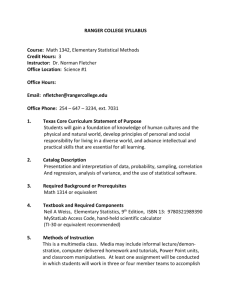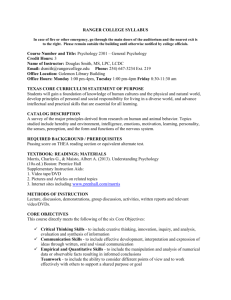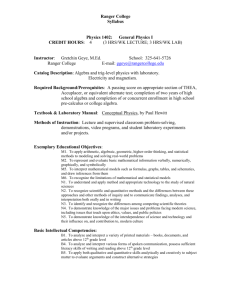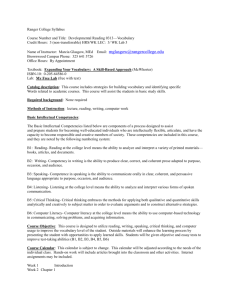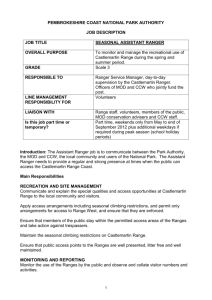Creating Gunslinger By Far the World's Most Fun Mixed
advertisement
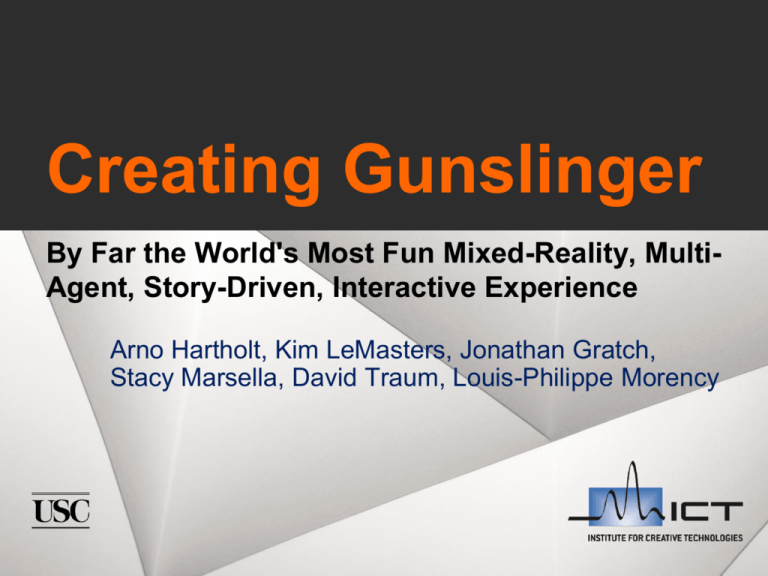
Creating Gunslinger By Far the World's Most Fun Mixed-Reality, MultiAgent, Story-Driven, Interactive Experience Arno Hartholt, Kim LeMasters, Jonathan Gratch, Stacy Marsella, David Traum, Louis-Philippe Morency Overview What is Gunslinger Related Work Gunslinger Architecture & Technology Design Approach Future Work Questions 2 3 Extensive Research on Interactive Narrative Goal-directed autonomous characters – Oz Project / Zoesis Mr. Bub (Bates; Loyall; Neal Reilly; Weyhraunch) – VICTEC / eCIRCUS (Dias & Paiva; Aylett et al) – MRE / SASO (Swartout et al.; Rickel) Interactive story management – – – – 4 Madame Bovary (Cavazza et al) Narrative Planning (Riedl & Young) Thespian (Si & Marsella) Façade (Mateas & Stern) Most systems mix some element of character autonomy with overarching story From Basic Research To Applied Projects MRE SASO-ST SASO-EN Virtual Humans Basic Research Applied Research and Applications 5 SASO-MP Architecture 7 Modules Speech recognition (Naryanan et al) – Push-to-talk or continuous Vision (Morency et al) – Facing – Distance to characters – Gun drawn NPCEditor (Leuski & Traum) – – – – 8 Statistical text classifier, mapping input to output Scripting engine Input: speech text strings, vision information, story state Output: character lines, sequences, story state updates Modules Nonverbal Behavior Generator (Lee & Marsella) – Generates gazes, head nods, selects animations – Body Markup Language (BML) SmartBody (Thiebaux, Marshall, Marsella, Shapiro) – Realizes BML – Synchronizes nonverbal behavior with pre-recorded speech Gamebryo (Emergent) – Rendering engine Aria (Sadek) – Surround sound – 3D localized sound through vibrating screen 9 Localized Sound 10 Story Overview Intro & Smalltalk Rio’s Entry 1 Practice Disengage Ambush Rio’s Entry 2 Rio’s Entry 2 Rio Dies 11 Rio & Utah Die Ranger Dies Rio Dies Ranger Dies Example Story state: utah-harmony-smalltalk Ranger input – “What is your name?” – Facing Harmony Response – Harmony: “My name is Harmony.” – No state change 12 Example Story state: utah-harmony-smalltalk Ranger input – “What is your name?” – Facing Utah Response – Utah: “My name is Utah. This here is my saloon. And you are?” – State change to ranger-name Ranger input – “I’m Jon.” Response – Utah: “That’s a citified name if I ever heard one. I think Ranger fits you better.” – Harmony: “Ranger. Well, that sounds dangerous. Are you married, Ranger?” – State change to ranger-married 13 Design: Traditional Challenge Tension between progress/research and fun Application often slave to the technology and research 14 Our Approach Fun first, AI second User experience is central – Single participant – One time experience Guide participants within story and keep them engaged Two key design principles – Provide total immersion – Give illusion of control 15 Immersion – Props 16 Immersion – Physical Set 17 Immersion – Ease in Experience 18 Immersion – Story & Characters Traditional story arc and elements – – – – Fleshed out characters – – – – 19 Highs and lows, flow of the story Anticipation Climax Obstacles Background Personality Motivation Feelings Professional writer and actors Immersion – Professional Creators Writer Set designers Set constructor Cinematographer Director Voice actors Motion caption actors Sound design 20 Immersion – Mood Tense Set at night, dramatically lit Thunderstorm, rain, lightning Visuals, touch, sound (maybe smell) 21 Illusion of Control Participants need to know what to do Participants need to feel their actions have effects and meaning 22 Illusion of Control – What to Do Iconic genre and themes – – – – Reinforce central themes with preshow – – – – Western Good guy vs. bad guy Damsel in distress Duel Sets up the world and story Introduces characters Introduces Ranger goals Provides hints and tips Character guidance – Offer advice – Answer questions – Force choices 23 Illusion of Control – Actions Have Meaning Characters always react to participant – Verbally, asking and answering questions – Nonverbally, looking at Ranger and others Participant can interrupt characters – Verbally, depending on character state – Nonverbally, drawing gun Mix of open ended and scripted interactions Offer small and big choices Inaction leads to defeat Design for multiple personalities – Timid – Aggressive 24 Status In mid development Formal user studies yet to be performed Informal feedback so far has been great – People love the real life set – Characters responding correctly to participant’s verbal and nonverbal actions is very powerful – Combination of participant and character initiative is very powerful – “I would definitely pay for this experience” – “This isn’t fun, it’s stressful!” 25 Future Work Multimodal fusion (speech and vision) Modeling multi-party dynamics & gaze behaviors Listener backchannel prediction Facial expression recognition Exploring social impact of emotional displays Exploring extent users obey social norms and exhibit social effects (i.e., treat computers as people) Data collection device to train models for recognizing/classifying/synthesizing human nonverbal behavior Research addressee recognition and policies Research interruption policies Overall performance and satisfaction for PTT vs. continuous ASR 27 NSF Museum Guides, Boston Museum of Science Figure 1: Visitors engaging with Ada and Grace at the Boston Museum of Science at their debut. 28 ICT Virtual Human Toolkit Virtual Human Toolkit 29 http://vhtoolkit.ict.usc.edu Questions? Virtual Human Toolkit: http://vhtoolkit.ict.usc.edu Email: hartholt@ict.usc.edu 30
